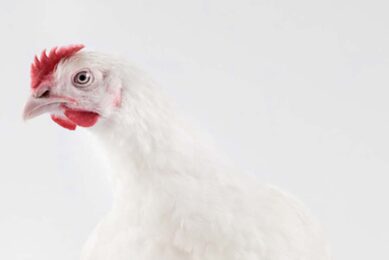Hatcheries to vaccinate against Gumboro

The control of infectious bursal disease (IBD), also known as Gumboro, will be better when vaccination takes place in the hatchery. Trial results prove that this practice provides a better protection to birds compared to the traditional water application.
By Wiebe van der Sluis
IBD remains an important infectious disease and needs to be controlled to deter losing birds or experiencing a dramatic drop in bird performance. Field studies show that the commonly practised water medication method is insufficiently protecting birds against the disease.
Either the vaccination takes place at the wrong time or birds receive an inadequate dose of the vaccine or not at all. To overcome this problem the control of IBD should start in the hatchery. This could be concluded from presentations during the Gumboro symposium organised by CEVA Sante Animal in Budapest last January.
Protecting against break trough
“Poultry shall become the consumer’s first choice of animal protein in the next ten years”, said Dr Sylvain Comte, Ceva’s corporate marketing director – poultry, in his opening address to more than 250 veterinarians from all over Europe. The limited availability of resources like water and feed force the poultry industry to further improve its production management so more can be produced with less input. It is Comte’s strong belief that pharmaceutical companies have to play an important role in meeting this goal. They have to offer producers sustainable solutions to give their birds a good protection against major diseases by developing a healthy immune system, in which the Bursa of Fabricius plays an important role.
“Poultry shall become the consumer’s first choice of animal protein in the next ten years”, said Dr Sylvain Comte, Ceva’s corporate marketing director – poultry, in his opening address to more than 250 veterinarians from all over Europe. The limited availability of resources like water and feed force the poultry industry to further improve its production management so more can be produced with less input. It is Comte’s strong belief that pharmaceutical companies have to play an important role in meeting this goal. They have to offer producers sustainable solutions to give their birds a good protection against major diseases by developing a healthy immune system, in which the Bursa of Fabricius plays an important role.
Young chicks are well protected against infection of the bursa by maternally derived antibodies, but at the time this antibody level drops the IBD virus can break through the protection. The virus is very tough and resistant, since it can survive in water, feed and manure for 52 days and in the chicken house for at least 122 days after removal of an infected flock. These houses have to be intensively disinfected with formaldehyde, chloramines or quats.
Insufficient protection
Protecting birds against IBD by conventional vaccination methods (drinking water, eye-drop or spray) requires perfect timing, warned Dr Sjaak de Wit of the Dutch Poultry Health Service in Deventer. In case there are still too many maternally derived antibodies (MDA) present the vaccine will be neutralised and when birds have a low MDA level they will be unprotected for a longer time. This means that serology tests have to be done to estimate the precise vaccination date. Research has shown that when birds had been vaccinated more than one day before the calculated optimal vaccination date (using the Deventer formula), the humoral immune response was delayed or not detectable until slaughter.
Protecting birds against IBD by conventional vaccination methods (drinking water, eye-drop or spray) requires perfect timing, warned Dr Sjaak de Wit of the Dutch Poultry Health Service in Deventer. In case there are still too many maternally derived antibodies (MDA) present the vaccine will be neutralised and when birds have a low MDA level they will be unprotected for a longer time. This means that serology tests have to be done to estimate the precise vaccination date. Research has shown that when birds had been vaccinated more than one day before the calculated optimal vaccination date (using the Deventer formula), the humoral immune response was delayed or not detectable until slaughter.
Nevertheless, when vaccinating at the accurate date by applying conventional methods there is still a chance of an infection. Field surveys showed that the efficacy of these vaccination methods is questionable. Dr Gurogy Banhidi, poultry franchise and technical manager for Ceva conducted a field survey and showed that the commonly used practice of drinking water vaccination insufficiently protects birds. The real coverage was less than 73%.
Banhidi told that the uneven seroconversion and uncertainty about vaccine take results from an uncomplete priming of the drinking water system, lack of moving of the flock and vaccinating at the wrong time. Even after improving priming and bird movement the coverage would not be more than 85%.
Hatchery vaccination
A better protection against IBD is possible through vaccinating birds at an earlier stage: actually in the hatchery by using an immune complex IBD vaccine. Dr Branko Alva, Ceva’s corporate poultry product manager explained that it is better to vaccinate properly in one place compared to vaccinating birds in dozens of farms. It will make life easier for farmers, technicians and vets. The time needed for vaccination will be reduced and the logistics to deliver the vaccine is easier, while there is a better control possible over maintaining the quality of the vaccine and the vaccination.
A better protection against IBD is possible through vaccinating birds at an earlier stage: actually in the hatchery by using an immune complex IBD vaccine. Dr Branko Alva, Ceva’s corporate poultry product manager explained that it is better to vaccinate properly in one place compared to vaccinating birds in dozens of farms. It will make life easier for farmers, technicians and vets. The time needed for vaccination will be reduced and the logistics to deliver the vaccine is easier, while there is a better control possible over maintaining the quality of the vaccine and the vaccination.
Immune complex vaccines can be applied for the active immunisation of healthy 18-day-old embryos by in-ovo vaccination or healthy day-old chicks against classical or very virulent IBD. Such a hatchery vaccination provides enough protection for all birds, so there is no need to revaccinate on the farm. Banhidi showed in his presentation that hatchery vaccination does, compared to water vaccination, not show heterogenity problems nor strain or timing issues. Vaccination in the hatchery assures that all birds will receive the right dosage of vaccine at a minimum of 98% precision.
With the poultry industry moving to industrialisation, more and more companies seem to prefer hatchery vaccination, says Alva. He showed that in 2006 2% of the 40 billion broilers produced in the world were already vaccinated in the hatchery. This number has increased to 25% of the 45 billion broilers produced in 2011, which, according to Alva, will increase over the years to come.
Join 31,000+ subscribers
Subscribe to our newsletter to stay updated about all the need-to-know content in the poultry sector, three times a week. Beheer
Beheer








 WP Admin
WP Admin  Bewerk bericht
Bewerk bericht